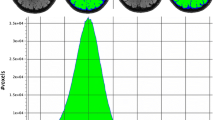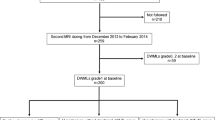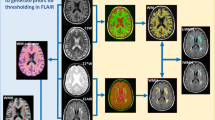Abstract
Introduction
We report on a method for the longitudinal follow-up of individual white matter hypersignals (WMH) and on its application to the study of WMH natural evolution in a cohort of 1,118 elderly over a 4-year period.
Materials and methods
For each subject, automated WMH detection was performed on T2-weighted MR images acquired both at baseline and at follow-up after registration in a common space. The detection algorithm was designed both to track WMH previously existing at baseline and to identify newly formed WMH.
Results
The average annual change in WMH load was found to be 0.25 cm3/year, 36% of this change being attributable to newly formed WMH. Quantitative analyses showed that change in WMH was mainly explained by progression of juxtaventricular and periventricular WMH while the load of WMH in the deep white matter zones was found stable over 4 years of the study. Statistical parametric mapping confirmed these spatial WMH change distributions in the juxta- and periventricular zones. High blood pressure was not a significant predictor of the annual change in WMH.
Conclusion
This study proposes a new scheme for the longitudinal study of WMH change by dissociating worsening of existent WMH from surfacing of new WMH and may thus contribute to help understanding and characterizing the neurological and etiological bases of these two processes and their potential differences.






Similar content being viewed by others
References
de Leeuw FE, de Groot JC, Achten E, Oudkerk M, Ramos LM, Heijboer R, Hofman A, Jolles J, Van GJ, Breteler MM (2001) Prevalence of cerebral white matter lesions in elderly people: a population based magnetic resonance imaging study. The Rotterdam Scan Study. J Neurol Neurosurg Psychiatry 70:9–14. doi:10.1136/jnnp.70.1.9
DeCarli C, Fletcher E, Ramey V, Harvey D, Jagust WJ (2005) Anatomical mapping of white matter hyperintensities (WMH): exploring the relationships between periventricular WMH, deep WMH, and total WMH burden. Stroke 36:50–55. doi:10.1161/01.STR.0000150668.58689.f2
Gunning-Dixon FM, Raz N (2000) The cognitive correlates of white matter abnormalities in normal aging: a quantitative review. Neuropsychology 14:224–232. doi:10.1037/0894-4105.14.2.224
Stewart R, Dufouil C, Godin O, Ritchie K, Maillard P, Delcroix N, Crivello F, Mazoyer B, Tzourio C (2008) Neuroimaging correlates of subjective memory deficits in a community population. Neurology 70:1601–1607. doi:10.1212/01.wnl.0000310982.99438.54
van der Flier WM, van Straaten EC, Barkhof F, Verdelho A, Madureira S, Pantoni L, Inzitari D, Erkinjuntti T, Crisby M, Waldemar G, Schmidt R, Fazekas F, Scheltens P (2005) Small vessel disease and general cognitive function in nondisabled elderly: the LADIS study. Stroke 36:2116–2120. doi:10.1161/01.STR.0000179092.59909.42
Guttmann CR, Benson R, Warfield SK, Wei X, Anderson MC, Hall CB, bu-Hasaballah K, Mugler JP III, Wolfson L (2000) White matter abnormalities in mobility-impaired older persons. Neurology 54:1277–1283
Whitman GT, Tang Y, Lin A, Baloh RW (2001) A prospective study of cerebral white matter abnormalities in older people with gait dysfunction. Neurology 57:990–994
Guerini F, Frisoni GB, Bellwald C, Rossi R, Bellelli G, Trabucchi M (2004) Subcortical vascular lesions predict functional recovery after rehabilitation in patients with L-dopa refractory parkinsonism. J Am Geriatr Soc 52:252–256. doi:10.1111/j.1532-5415.2004.52064.x
Prins ND, van Dijk EJ, den HT, Vermeer SE, Koudstaal PJ, Oudkerk M, Hofman A, Breteler MM (2004) Cerebral white matter lesions and the risk of dementia. Arch Neurol 61:1531–1534. doi:10.1001/archneur.61.10.1531
Godin O, Dufouil C, Maillard P, Delcroix N, Mazoyer B, Crivello F, Alperovitch A, Tzourio C (2008) White matter lesions as a predictor of depression in the elderly: the 3C-Dijon study. Biol Psychiatry 63:663–669. doi:10.1016/j.biopsych.2007.09.006
Thomas AJ, Perry R, Barber R, Kalaria RN, O’Brien JT (2002) Pathologies and pathological mechanisms for white matter hyperintensities in depression. Ann N Y Acad Sci 977:333–339
Soderlund H, Nyberg L, Adolfsson R, Nilsson LG, Launer LJ (2003) High prevalence of white matter hyperintensities in normal aging: relation to blood pressure and cognition. Cortex 39:1093–1105. doi:10.1016/S0010-9452(08)70879-7
Park MK, Jo I, Park MH, Kim TK, Jo SA, Shin C (2005) Cerebral white matter lesions and hypertension status in the elderly Korean: the Ansan Study. Arch Gerontol Geriatr 40:265–273. doi:10.1016/j.archger.2004.09.003
Maillard P, Delcroix N, Crivello F, Dufouil C, Gicquel S, Joliot M, Tzourio-Mazoyer N, Alperovitch A, Tzourio C, Mazoyer B (2008) An automated procedure for the assessment of white matter hyperintensities by multispectral (T1, T2, PD) MRI and an evaluation of its between-centre reproducibility based on two large community databases. Neuroradiology 50:31–42. doi:10.1007/s00234-007-0312-3
Sachdev P, Wen W, Chen X, Brodaty H (2007) Progression of white matter hyperintensities in elderly individuals over 3 years. Neurology 68:214–222. doi:10.1212/01.wnl.0000251302.55202.73
Schmidt R, Enzinger C, Ropele S, Schmidt H, Fazekas F (2003) Progression of cerebral white matter lesions: 6-year results of the Austrian Stroke Prevention Study. Lancet 361:2046–2048. doi:10.1016/S0140-6736(03)13616-1
Taylor WD, Steffens DC, MacFall JR, McQuoid DR, Payne ME, Provenzale JM, Krishnan KR (2003) White matter hyperintensity progression and late-life depression outcomes. Arch Gen Psychiatry 60:1090–1096. doi:10.1001/archpsyc.60.11.1090
van den Heuvel DM, Admiraal-Behloul F, ten Dam VH, Olofsen H, Bollen EL, Murray HM, Blauw GJ, Westendorp RG, de Craen AJ, van Buchem MA (2004) Different progression rates for deep white matter hyperintensities in elderly men and women. Neurology 63:1699–1701
Taylor WD, MacFall JR, Provenzale JM, Payne ME, McQuoid DR, Steffens DC, Krishnan KR (2003) Serial MR imaging of volumes of hyperintense white matter lesions in elderly patients: correlation with vascular risk factors. AJR Am J Roentgenol 181:571–576
Alperovitch A, Amouyel P, Dartigues JF, Ducimetiere P, Mazoyer B, Ritchie K, Tzourio C (2002) Epidemiological studies on aging in France: from the PAQUID study to the Three-City study. C R Biol 325:665–672. doi:10.1016/S1631-0691(02)01476-2
Dufouil C, Kersaint-Gilly A, Besancon V, Levy C, Auffray E, Brunnereau L, Alperovitch A, Tzourio C (2001) Longitudinal study of blood pressure and white matter hyperintensities: the EVA MRI Cohort. Neurology 56:921–926
Woods RP, Cherry SR, Mazziotta JC (1992) Rapid automated algorithm for aligning and reslicing PET images. J Comput Assist Tomogr 16:620–633. doi:10.1097/00004728-199207000-00024
Kim KW, MacFall JR, Payne ME (2008) Classification of white matter lesions on magnetic resonance imaging in elderly persons. Biol Psychiatry 64:273–280. doi:10.1016/j.biopsych.2008.03.024
Friston KJ, Holmes AP, Worsley KJ, Poline JB, Frith CD, Frackowiak RSJ (1995) Statistical parametric maps in functional imaging: a general approach. Hum Brain Mapp 2:189–210
Markus HS, Hunt B, Palmer K, Enzinger C, Schmidt H, Schmidt R (2005) Markers of endothelial and hemostatic activation and progression of cerebral white matter hyperintensities: longitudinal results of the Austrian Stroke Prevention Study. Stroke 36:1410–1414. doi:10.1161/01.STR.0000169924.60783.d4
Prins ND, van Straaten EC, van Dijk EJ, Simoni M, van Schijndel RA, Vrooman HA, Koudstaal PJ, Scheltens P, Breteler MM, Barkhof F (2004) Measuring progression of cerebral white matter lesions on MRI: visual rating and volumetrics. Neurology 62:1533–1539
ten Dam VH, van den Heuvel DM, van Buchem MA, Westendorp RG, Bollen EL, Ford I, de Craen AJ, Blauw GJ (2005) Effect of pravastatin on cerebral infarcts and white matter lesions. Neurology 64:1807–1809
van den Heuvel DM, ten Dam VH, de Craen AJ, Admiraal-Behloul F, van Es AC, Palm WM, Spilt A, Bollen EL, Blauw GJ, Launer L, Westendorp RG, van Buchem MA (2006) Measuring longitudinal white matter changes: comparison of a visual rating scale with a volumetric measurement. AJNR Am J Neuroradiol 27:875–878
Admiraal-Behloul F, van den Heuvel DM, Olofsen H, van Osch MJ, van der GJ, van Buchem MA, Reiber JH (2005) Fully automatic segmentation of white matter hyperintensities in MR images of the elderly. Neuroimage 28:607–617. doi:10.1016/j.neuroimage.2005.06.061
de Leeuw FE, Richard F, de Groot JC, van Duijn CM, Hofman A, Van GJ, Breteler MM (2004) Interaction between hypertension, apoE and cerebral white matter lesions. Stroke 35:1057–1060. doi:10.1161/01.STR.0000125859.71051.83
Liao D, Cooper L, Cai J, Toole JF, Bryan NR, Hutchinson RG, Tyroler HA (1996) Presence and severity of cerebral white matter lesions and hypertension, its treatment, and its control. The ARIC Study. Atherosclerosis Risk in Communities Study. Stroke 27:2262–2270
van Dijk EJ, Breteler MM, Schmidt R, Berger K, Nilsson LG, Oudkerk M, Pajak A, Sans S, de RM, Dufouil C, Fuhrer R, Giampaoli S, Launer LJ, Hofman A (2004) The association between blood pressure, hypertension, and cerebral white matter lesions: cardiovascular determinants of dementia study. Hypertension 44:625–630. doi:10.1161/01.HYP.0000145857.98904.20
Launer LJ, Berger K, Breteler MM, Dufouil C, Fuhrer R, Giampaoli S, Nilsson LG, Pajak A, de RM, van Dijk EJ, Sans S, Schmidt R, Hofman A (2006) Regional variability in the prevalence of cerebral white matter lesions: an MRI study in 9 European countries (CASCADE). Neuroepidemiology 26:23–29. doi:10.1159/000089233
Fazekas F (1989) Magnetic resonance signal abnormalities in asymptomatic individuals: their incidence and functional correlates. Eur Neurol 29:164–168. doi:10.1159/000116401
Hopkins RO, Beck CJ, Burnett DL, Weaver LK, Victoroff J, Bigler ED (2006) Prevalence of white matter hyperintensities in a young healthy population. J Neuroimaging 16:243–251
Wen W, Sachdev PS, Li JJ, Chen X, Anstey KJ (2008) White matter hyperintensities in the forties: their prevalence and topography in an epidemiological sample aged 44–48. Hum Brain Mapp. doi:10.1002/hbm.20586
Schmidt R, Fazekas F, Reinhart B, Kapeller P, Fazekas G, Offenbacher H, Eber B, Schumacher M, Freidl W (1996) Estrogen replacement therapy in older women: a neuropsychological and brain MRI study. J Am Geriatr Soc 44:1307–1313
van den Heuvel DM, ten Dam VH, de Craen AJ, Admiraal-Behloul F, Olofsen H, Bollen EL, Jolles J, Murray HM, Blauw GJ, Westendorp RG, van Buchem MA (2006) Increase in periventricular white matter hyperintensities parallels decline in mental processing speed in a non-demented elderly population. J Neurol Neurosurg Psychiatry 77:149–153. doi:10.1136/jnnp.2005.070193
Acknowledgments
P. Maillard has been supported by a grant from the Ministère de l’Enseignement Supérieur et de la Recherche. The authors are indebted to P. Karamian, P. Guillon, V. Besançon, O. Coskun, and S. Bricogne for early contributions to this work. This study has been conducted within the framework of the ICBM project (http://www.loni.ucla.edu/ICBM/).The Three-City Study is conducted under a partnership agreement between the Institut National de la Santé et de la Recherche Médicale (INSERM), the Victor Segalen-Bordeaux II University, and Sanofi-Aventis. The Fondation pour la Recherche Médicale funded the preparation and initiation of the study. The 3C Study is also supported by the Caisse Nationale Maladie des Travailleurs Salariés, Direction Générale de la Santé, MGEN, Institut de la Longévité, Conseils Régionaux of Aquitaine and Bourgogne, Fondation de France, and Ministry of Research-INSERM Programme “Cohortes et collections de données biologiques.”
Conflict of interest statement
We declare that we have no conflict of interest.
Author information
Authors and Affiliations
Corresponding author
Rights and permissions
About this article
Cite this article
Maillard, P., Crivello, F., Dufouil, C. et al. Longitudinal follow-up of individual white matter hyperintensities in a large cohort of elderly. Neuroradiology 51, 209–220 (2009). https://doi.org/10.1007/s00234-008-0489-0
Received:
Accepted:
Published:
Issue Date:
DOI: https://doi.org/10.1007/s00234-008-0489-0




